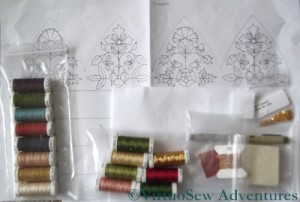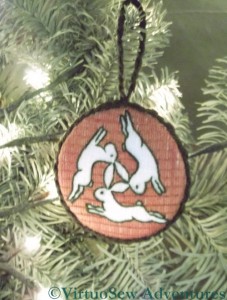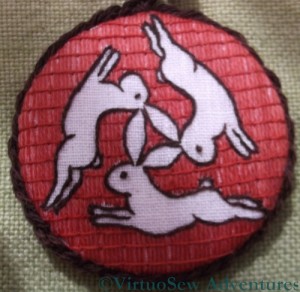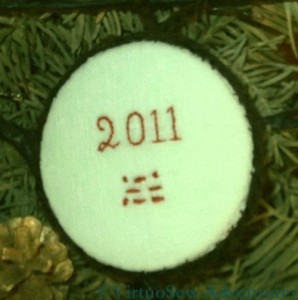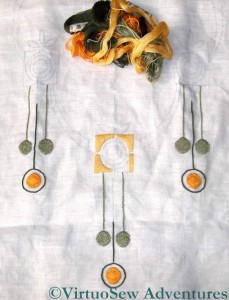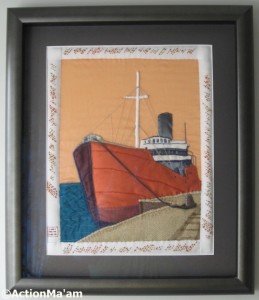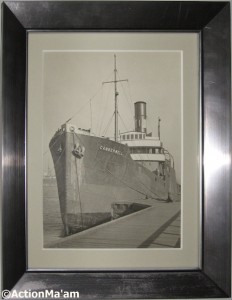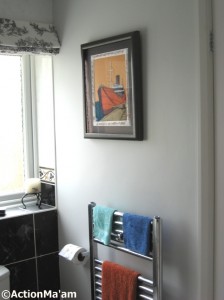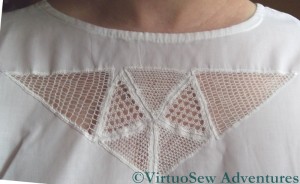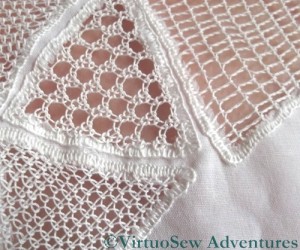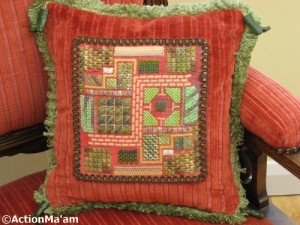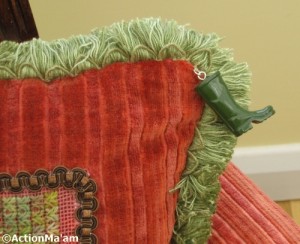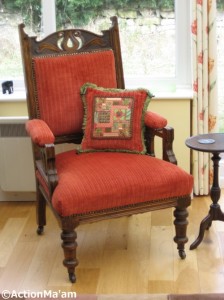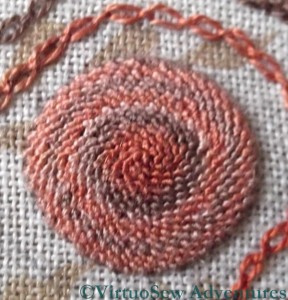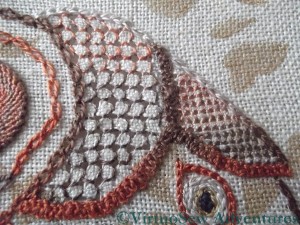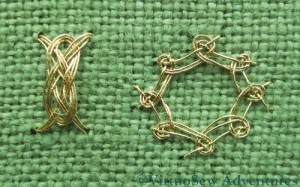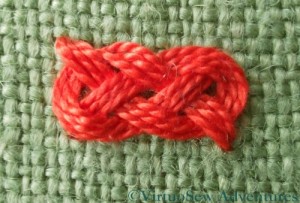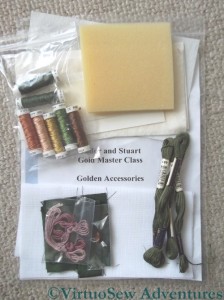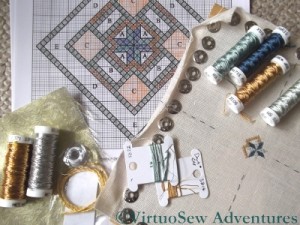Category: General Embroidery
Glittering Nightcap – Materials Arrived
Although I am very tempted by Tricia Nguyen-Wilson’s Cabinet of Curiosties Casket Course (who wouldn’t be?) I decided that I really shouldn’t take on a multi-year project such as that would certainly turn out to be, not least because I really want to do more on the Dreams of Amarna Panels.
I couldn’t quite do without an Online University course, though, so I have signed up to the Glittering Nightcap Course, and the materials arrived just before Christmas. Eight colours of Gilt Sylke Twist, as well as all the other silk thread, real spangles (tiny ones), a Japanese needle, and even a Pigma pen (for which I am devoutly grateful, because my local – usually very good – artists’ suppliers was completely non-plussed when I asked about them. I suppose it’s an American brand.
I shan’t be able to start before the middle of January or maybe even later, but I’m really looking forward to it. It will be interesting to get to grips with Gilt Sylke Twist, having heard so much about it!
Another variation on the Three Hares
When I wrote about the Three Hares design I created for Handmade Living magazine, I mentioned that I was rather taken with the design as a framework for experimentation. I have an idea in my head for quite a big project based on the design, but while that’s simmering away and developing in my head, I have gone in the other direction.
This is a much smaller and much more complex version, but maintaining the historical connection, I chose to use Bayeux Stitch (there is a diagram in this Embroiderer’s Guild pdf) for the background. The stitching uses fine woollen threads on a linen ground, and naturally I followed my usual habit of increasing the complexity of my adventures in stitchery.
Bayeux Stitch is worked in two phases, of which the first is surface satin stitch. I chose to alternate two shades of rust for the surface satin stitch, and then the couching stitches went over the top using the darker shade. It doesn’t really show in the photographs, which were taken in rather dismal lighting conditions, but it does show in real life, and it makes the background shimmer slightly – which is a good trick when there’s no metallic thread involved!
Whereas in the first variant, created for Handmade Living magazine, I simply outlined the design, gaining all of the interest from the contrast of fabric and thread, in this case I outlined the motif (in back stitch), then covered the background completely with stitching.
Finally, I turned the embroidery into a hanging decoration by the same method used for the Glittering Snail, but before I covered the back with fabric, I added the year and then my initials in Morse Code.
Progress on the Finnish Embroidery
I managed to get started on my Finnish embroidery project at last. It’s going to be a table runner for our dining room, which is golden-yellow and decorated in a slightly Arts and Crafts fashion, so the design has been traced twice, back to back, to create a long design, and without the lettering shown in the photograph that accompanied the linen (see my first post about this project).
Following the model I saw in the shop, I’m using Bokhara Couching for all the solid shapes, laying the couching stitches in a sort of brickwork pattern to create texture. The deep golden circles will echo the sunburst in the eucalyptus frieze in the dining room, and the two greyish greens are close to the other colours in the frieze.
All the lines are going to be in stem stitch. I’m working this quite slowly and carefully to keep the stem stitch twisting neatly in the same direction and the stitch length more or less the same.
It’s some time off yet, but I’m planning to hand-hemstitch the edge of the runner. I take a slightly unexpected pleasure from hand-hemstitching, and even the six metres of hemstitching on the Piano Shawl haven’t put me off. There’ll be about three metres of hemstitching on this, and I’m rather looking forward to it!
..And the Sailor home from the Sea.
Once the Camberwell was finished, I handed the piece, still stretched on the bars I used to work it, over to my client (Action Ma’am) and her picture framer. I’m very pleased with what they came up with, so I’ve asked her to write up a little bit about framing the piece and where the Camberwell is living now.
At quite an early stage, I had decided that Camberwell was going to hang in the bathroom. An odd choice, maybe, but her colours went beautifully with the accent colours I had already chosen and the theme of nauticalia.
My local picture framer enthusiastically accepted the challenge of creating a suitable box-frame. We chose a rounded moulding, to echo the curve of the funnel, and charcoal for both mount and moulding to match the colour of the ribbon used for the funnel. Since it was to hang by an east-facing window, we selected a grade of conservation glass which excludes 98% of UV light. I took the opportunity to have the inspirational photo properly mounted in the frame I had bought for it from a high-street newsagent a year or so previously.
The pictures now hang either side of the bathroom door. Rachel and I had a little ceremony with sparkling white wine to hang the finished panel. I can bore for England on how wonderful it is, and admire it in comfort whilst lounging in the bath.
The title of this post is taken from RL Stevenson’s “Requiem” – text here. Or alternatively from AE Housman’s “Home Is The Sailor” (here). We both thought it was the right title, but neither of us could remember where we’d heard it, and when I Googled for it, I found myself with a positive embarrassment of riches!
A Needlelace Embellished Blouse
I must have worked the Needlelace Embellished Blouse when I was sixteen or seventeen – probably it was about the third or fourth project that I did, ever. Once I’d got hooked on embroidery – which happened over a piece that I’ve yet to show you, partly because I’m not sure where it’s hidden itself – I went from technique to technique and project to project almost without drawing breath!
I wanted something “Floral-inspired but modern”, I remember, so my mother suggested a pentagon for a flower and triangles for leaves. Thus:
We divided the pentagon into triangles, because I wanted to use three different needlelace stitches (and also because it would be more interesting that way), and transferred it to a boat-necked summer top with a V at the back.
It’s hardly surprising I gave needlelace a try – both Grandmama and my mother had worked needlelace embellished table cloths, so it was in the air, so to speak. It’s also not surprising that I didn’t attempt another tablecloth. Even then I knew that I didn’t have the patience for that size of project!
The triangles forming the flower I worked either in Pea Stitch or Corded Single Brussels Stitch, and the “leaves” were Corded Point d’Espagne. There’s a Needlelace Tutorial starting here on a lacemakers’ website for those who are interested. Then I buttonholed the edges (the wrong way round, I think, now I look at the photo again!) and, with much trepidation, cut away the fabric at the back.
And it worked! I wore the blouse quite a lot for a few years, and now I’ve found it again I suspect I’ll be wearing it some more – although not this year <shiver>!
Further Adventures In The Abstract Garden
You may recall that I worked an abstract piece of canvaswork inspired by a vegetable garden. When I’d finished it, I didn’t like it very much, and really didn’t know what to do with it. However, my cousin (who comments here occasionally as Action Ma’am) did not suffer from the same problem. Not only did she like it, she knew what to do with it. I’ve asked her to write up what she did, and here’s what she wrote:
Having commented how the abstract garden canvas reminded me of my veg garden, I was delighted when Rachel offered it to me. I knew exactly what to do – it had already told me it wanted to be on a cushion for the armchair in the conservatory. My guess that the red of the canvas was the same as the red of the upholstery was spot on.
I don’t have a sewing machine, so Fiona my curtain-maker agreed to put the cover together for me. Not having done any needlework for many years, I was quite alarmed at the prospect of “getting it right”. Rachel and I had an email discussion about how to straighten the canvas and apply it to the velvet, handstitching it in place. To emphasize the garden theme, I had chosen some gimp braid to cover the edges of the canvas. The loops of the braid echo the hoops of the iron edging you sometimes find around borders in posh parks and gardens. I also chose some green fringe to define clearly where the cushion ended and the chair began.
Whilst I was still thinking about getting started, Fiona phoned to say she could deliver a bedspread she had been making for me the next day. This was too good an opportunity to miss. I took the afternoon off work, a deep breath, gritted my teeth and leapt in. The stripes on the velvet helped in getting the canvas straight, the braid hid the edge of the canvas, and two hours later, it was ready for Fiona.
Whilst the cover was away being made up, I found a necklace in an accessories shop, with a green wellington boot charm on it. I bought four as a finishing touch.
The abstract garden canvas is now a happy cushion, nestling into the crook of the chair arm, and kicking its welly-booted heels in the air. I don’t think the chair intends letting go of it any time soon!
Close-ups on the Elephant Doorstop
I’ve been asked to provide a few close ups from the Elephant Doorstop, so here goes.
This close-up shows the spiral trellis stitch medallion on the Elephant’s ear. I love this stitch – it creates a lovely nubbly texture! It’s about three quarters of an inch across.
The silk perlé I am using was in ready cut lengths, shading from orange to brown, and when I brought a new thread in, I started with the colour I’d just finished, so that the colour sections would be slightly longer and denser.
When I thought about working four-sided stitch on the Elephant’s headcloth, I was originally intending to work some other pattern over the top, so the background grid would modify the fabric and the pattern on the top would be the most visible thing. However, I couldn’t decide what size would be best and worked one section in each size, and now I’ve decided I like it just as it is. It recalls the Trellis Couching on the saddlecloth, but at a different orientation.
Tudor and Stuart Masterclass – Month Seventeen
Month Seventeen’s stitches were Eight Sided Interlacing Stitch, and the Josephina Knot. I rather enjoyed them, too – they’re both very ornamental indeed!
The Eight Sided Stitch is less scary than you might expect on first sight, although I was slightly surprised to realise that the foundation layer interlaced in the direction contrary to the one I expected.
It will be more exciting at the smaller size on the real sampler, but I feel that I understand the structure, at least, and that is the important point, at this stage.
However, if you look at the gold Josephina Knot in the top picture, you will see that I didn’t quite get the hang of that one…
This pearl cotton version shows what I was aiming for. It’s a really lovely ornamental spot stitch, with a slightly Celtic feel to it. However, if the interlacing goes wrong at any point during the working, it is very hard to recover – and not always easy to see before you’ve finished, either.
I made extensive use, for these stitches, of a belated birthday present from Elmsley Rose – a set of bone needlework awls/stilettos. I have a steel laying tool, but it’s so sharp that it’s not a good tool for coaxing threads into place. My birthday presents were just perfect – Thank You, Megan!
Tudor and Stuart Goldwork Masterclass – Bonus Instructions
There was a set of Bonus Instructions in the instructions for Month Fifteen, from a teaching project that Tricia had retired from use. She was asked whether she’d produce kits of the materials for those of us who don’t have easy (or even difficult!) access to a really good needlework shop. Yet again, apparently, demand outstripped her expectations (a good problem to have!), and here is my kit.
It includes finishing materials for the various accessories, as well as the fabric and the silk thread, but not the metal thread, since all of us already have large spools of that from doing the main Spot Sampler.
My intention is to finish these to add to that planned “winter decoration corner” I’ve mentioned a couple of times. I’ve found some masks which I’m going to decorate in silver and gold, and I will use some metallic gauze or something similar for the background. Already the two Needlework Nibbles, the Floral Glove Needlecase and the Tudor Pincushion look like they will create some wonderful reflective textures for a dark corner…
Tudor and Stuart Masterclass – Beginning the Petite Pincushion
There were two additional projects included in the Tudor and Stuart Goldwork Masterclass, to provide further opportunities to use some of the stitches we are learning. The Tudor Pincushion was one, and this “Petite Pincushion” is the second. The materials include a piece of silk brocade for the backing, some gold cord to provide an ornamental edge, and more spools of assorted metal threads for the goldwork stitches.
Whereas the silk stitchery for the Tudor Pincushion was in primarily in Tent Stitch, most of the silk work on the Petite Pincushion is in Queen Stitches. I’ve not done any since I finished the silkwork on the sampler, and I am finding that I am having to remind myself to pull them tight to create the openwork effect. I will have to remember to line the embroidered side of the pincushion or the stuffing will poke out through the gaps!
I stitched centre lines on the fabric, but as you can see, once I had the first stitch placed I snipped out the middle stitches and pulled them back out of the way.
I’ve already finished with two of the silk colours, which appear only in the central starburst. Now I just have to do rows of strapwork in the other two colours, as well as the four blocks of tent stitches that provide a basis for a rather intriguing-looking interwoven stitch which will probably be nearly the last element I add.

